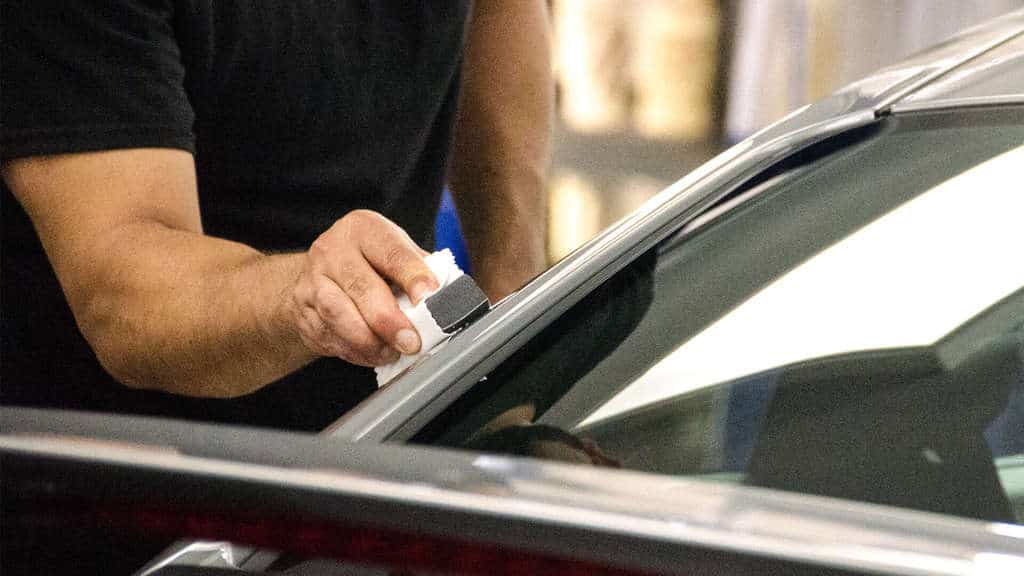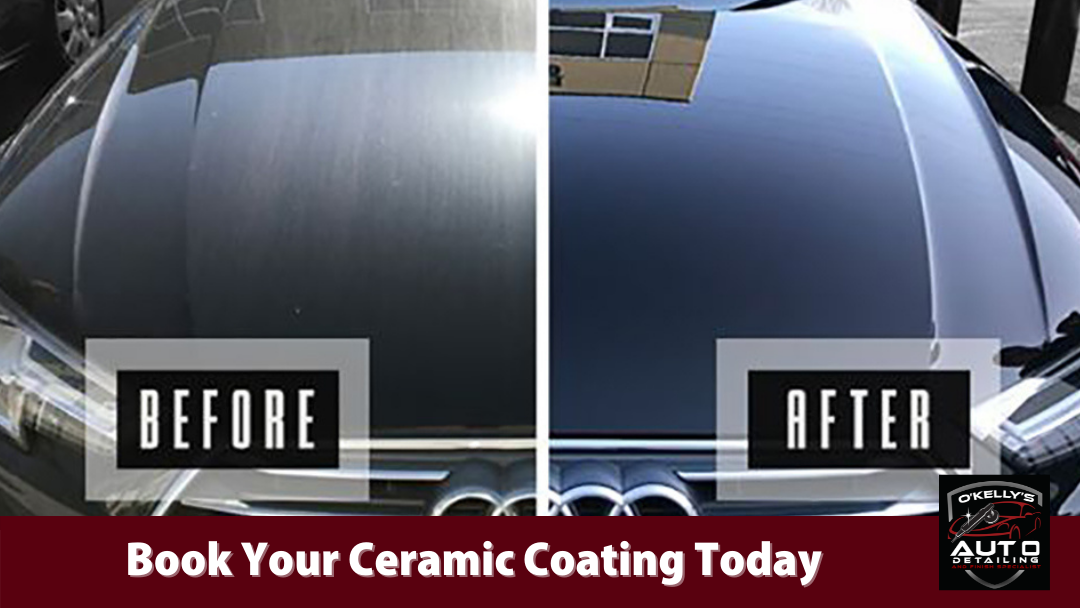Exactly How Ceramic Coating Safeguards Your Cars and truck's Paint and Keeps It Looking New
Ceramic layer has actually arised as a sophisticated service for automotive paint security, supplying an awesome obstacle versus the elements. By creating a hydrophobic layer that bonds with the car's existing surface, this sophisticated innovation not just drives away water but also defend against environmental contaminants and hazardous UV rays. The result is a considerable decrease in paint destruction and a long-lasting aesthetic charm. Understanding the complexities of how this process functions and the benefits it supplies can significantly influence your vehicle upkeep method. What lies below the surface of this cutting-edge technique?
What Is Ceramic Covering?

When applied appropriately, ceramic finishings form a semi-permanent bond with the surface area of the vehicle, using superior defense against UV rays, chemical discolorations, and minor scrapes - ceramic coating. Unlike standard wax or sealants that might disappear within months, ceramic coatings can last for several years, depending upon the item and maintenance
The application procedure involves detailed surface preparation, consisting of washing, decontaminating, and brightening the paint to ensure ideal attachment. Once the finishing is used, it treatments and hardens, resulting in a hydrophobic surface that pushes back dust, water, and grime. This hydrophobic property not only makes the car less complicated to tidy but also improves the general gloss and clearness of the paint, adding to a showroom-quality coating. Ceramic covering is increasingly favored by automobile lovers and experts looking for resilient paint defense.
Benefits of Ceramic Covering
Why should automobile owners take into consideration buying ceramic coating? The benefits of ceramic coating extend far past plain visual appeals, using significant protection and long life for a lorry's paintwork. Among the main advantages is its remarkable resistance to environmental impurities. Ceramic finishes produce a hydrophobic surface area, enabling dust, water, and grime to slide off conveniently, minimizing the frequency of cleaning and the need for typical waxes.
Additionally, ceramic layers offer a durable shield versus UV rays, which can create paint to oxidize and discolor in time. This protective layer assists keep the vibrancy and gloss of the automobile's shade, ensuring it looks brand-new for several years. Ceramic coatings are known for their toughness; they can last numerous years with proper maintenance, making them an economical financial investment in the lengthy run (ceramic coating).
Another significant benefit is the ease of upkeep they use. With a ceramic-coated surface, minor scratches and swirl marks are less most likely to take place, and when they do, they are easier to buff out. Generally, the investment in ceramic finishing not only improves the aesthetic charm of a lorry yet additionally provides lasting protection that can save vehicle owners time and money.
Exactly How Ceramic Finishing Functions
Comprehending exactly how ceramic finish jobs is crucial for car proprietors considering this safety remedy for their vehicle's paint. Ceramic coverings are composed of advanced nanotechnology that forms a resilient, protective layer over the surface of the automobile's paint. When used, these liquid polymers bond chemically with the factory paint, producing a strong, hydrophobic layer that fends off water, dirt, and other contaminants.
The primary component in ceramic coatings is silicon dioxide (SiO2), which offers the finish's solidity and resistance to UV chemicals, rays, and scrapes. This molecular bonding develops a protective shield that is dramatically harder than conventional wax Discover More or sealants, providing lasting protection. The hydrophobic nature of the coating indicates that water beads up and rolls off the surface area, taking dirt and crud with it, consequently making the car easier to cleanse.

Application Process of Ceramic Finishing
The application procedure of ceramic layer calls for mindful preparation and focus to detail to ensure optimal outcomes. At first, the vehicle needs to undertake a complete cleaning to eliminate dust, gunk, and impurities. This action often includes a clay bar therapy to eliminate embedded bits that can compromise the finish's adhesion.
Complying with the cleaning, an in-depth inspection of the paint surface is necessary. Any kind of existing imperfections, such as scratches or swirl marks, ought to be attended to through polishing. This guarantees a reflective and smooth surface area, enhancing the final appearance of the ceramic finish.
As soon as the paint is prepared, the ceramic covering is applied in a regulated setting to avoid dirt and particles from contaminating the surface. Utilizing a specialized applicator, the finish is equally dispersed in areas, enabling correct bonding with the paint. It is crucial to adhere to the supplier's standards relating to healing times and ecological conditions during application.
After the application, a curing duration is required for the coating to achieve its full safety homes. This process can vary in duration based upon the certain product used, but it is vital for read this article attaining the wanted toughness and durability of the ceramic finishing.
Maintenance Tips for Ceramic Coating
Preserving a ceramic coating is necessary for protecting its safety homes and ensuring the longevity of your vehicle's outside. Avoid automated car washes, as their rough chemicals and brushes can deteriorate the layer.
After washing, wash extensively and dry the automobile with a clean microfiber towel to avoid water spots. It's a good idea to execute maintenance laundries every 2 weeks to keep the finishing in excellent problem.
Additionally, think about using a dedicated ceramic finishing booster or spray sealer every couple of months. These products improve the hydrophobic buildings and add an added layer of protection.
Inspect your vehicle on a regular basis for any kind of contaminants such as tree sap, bird droppings, or roadway tar, and eliminate them without delay using a clay bar if required. Park your car in a garage or use an automobile cover to reduce exposure to severe environmental aspects. ceramic coating. By complying with these maintenance suggestions, you can make certain that your ceramic coating remains reliable and your car retains its display room sparkle
Conclusion
To conclude, ceramic layer functions as a necessary protective measure for auto paint, using various advantages such as improved sturdiness and resistance to environmental threats. The sophisticated chemical bonding process makes certain a resilient shield versus pollutants, UV rays, and oxidation, thereby maintaining the car's visual charm. Proper application and upkeep are essential for making the most of the efficiency of ceramic coverings, inevitably adding to a lorry's durability and keeping a showroom-quality finish with time.
Ceramic finishing is a cutting-edge safety remedy developed to preserve the appearance and boost of car paint. Ceramic layer is increasingly preferred by car lovers and specialists seeking resilient paint defense.
Understanding exactly how ceramic layer works is necessary for car owners considering this protective solution for their car's paint. Ceramic layers are composed of sophisticated nanotechnology that forms a resilient, protective layer over the surface area of the cars and truck's paint.The key component in ceramic finishings is silicon dioxide (SiO2), which supplies the layer's hardness and resistance to UV scrapes, chemicals, and rays.